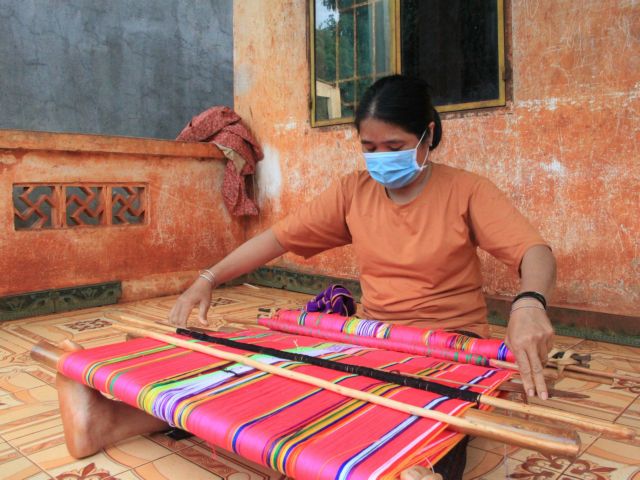.jpg) Society
Society
.jpg)
 |
| Thị Bình in Phú Riềng District’s Phú Riềng Commune in Bình Phước Province weaves brocade fabrics in her free time. S’tiêng ethnic people in the province weave brocade fabrics in their house, and pass down the traditional craft to the younger generations. — VNA/VNS Photo |
BÌNH PHƯỚC — The southeastern province of Bình Phước is actively working to preserve and promote the traditional crafts and cultural heritage of its ethnic minorities.
Bình Phước is home to 41 ethnic minority groups, comprising over 200,000 people, which account for 20 per cent of its total population.
The largest groups include the S'tiêng, Khmer, Tày, and M'nông.
The S'tiêng alone number around 100,000, making them the most populous ethnic group in the province.
Last year the province People's Committee unveiled a plan to safeguard and promote the traditional cultures of the S'tiêng, M'nông and Khmer peoples that focuses on advocacy efforts to raise public awareness, particularly among these ethnic groups, about the importance of preserving their cultural heritage.
Hớn Quản District is one of the province’s key areas with a significant ethnic population.
Ethnic communities reside in 77 of its 102 hamlets, making up 22 per cent of the population.
Many engage in traditional crafts such as brocade weaving, pottery, making musical instruments, and producing cần wine, a fermented rice wine infused with herbs and drunk through long bamboo straws.
The district has launched a project to preserve and develop traditional ethnic crafts, with brocade weaving selected as a key focus.
Two brocade weaving groups have been established, and, in collaboration with the Provincial Farmers Association's vocational training centre, two training courses were conducted last year for 80 participants.
According to Phạm Trung, deputy head of the Hớn Quản Ethnic Minority Affairs Bureau, further training programmes on traditional crafts will be organised in the near future.
He emphasised that the sustainability of these crafts depends on their commercial viability, ensuring that artisans generate a steady income.
“The district has developed several traditional craft products that have been recognised under the national 'One Commune - One Product' programme. It has also hosted ethnic cultural days and published booklets to promote traditional crafts.”
Many ethnic people are actively involved in preserving and promoting their traditional crafts and cultures.
Thị Mương, a S'tiêng woman from Bù Dinh hamlet in Thạnh An Commune, is renowned for producing refined brocade items.
She has established a brocade weaving group in her hamlet and teaches fellow S'tiêng women the craft.
She also founded a cồng chiêng (gong) performance group with over 30 members, whom she personally trains.
“The younger generation is showing less interest in our traditions,” she said.
“Teaching them traditional crafts is essential, and greater efforts are needed to preserve the cultural identities of ethnic minorities.”
Thị Kmắp, a Khmer woman, has been teaching traditional dances and ngũ âm (Khmer traditional music) to children in the Sóc Lớn Pagoda’s performance team in Lộc Ninh District’s Lộc Khánh Commune.
She said: “Alongside my daily work, I spend time with the children during their lessons and performances. Seeing their enthusiasm for learning makes me very happy. The team performs at Khmer traditional festivals and other local events.”
The Việt Nam Youth Federation in Bù Đốp District has also set up various groups and clubs to engage young people in preserving ethnic cultures.
Bù Đốp has significant Tày and Nùng populations, and the district’s branch of the federation has established clubs dedicated to preserving the cultural identities of these ethnic groups.
One such club, "Young People Preserve the Cultural Identities of Tày and Nùng Ethnic Minorities,” focuses on traditional arts, while another, "Hát Then - Đàn Tính," promotes a unique combination of song and music performances.
Nông Thị Hồng Hà of Tân Tiến Commune said: “We grew up with Then singing and Đàn Tính music, so learning them feels natural. The club meets at weekends, so it does not interfere with our daily work.
“Our elders teach us with great enthusiasm, and we deeply appreciate their efforts in preserving our cultural heritage for future generations.”
The practice of Then singing by Việt Nam’s Tày, Nùng and Thái ethnic groups has been recognised as an intangible cultural heritage of humanity by UNESCO.
Lộc Ninh District has also taken steps to preserve ethnic culture, establishing a group in Lộc Hòa Commune two years ago.
Members meet monthly at the 8B Hamlet Culture House to practise gongs under the guidance of village elder Điểu Phun.
Participants learn to play gongs and perform traditional dances, showcasing their skills at Lunar New Year celebrations and other festivals.
Nguyễn Công Toại, secretary of the Lộc Hòa Commune Youth Union, said the group started with 12 S'tiêng members and has now grown to 50.
Besides teaching gong performances, Điểu Phun also shares knowledge of traditional customs with the group.
The cultural space of gongs has also been recognised as an intangible cultural heritage of humanity, highlighting its significance in Việt Nam's rich cultural tapestry. — VNS
.jpg)



